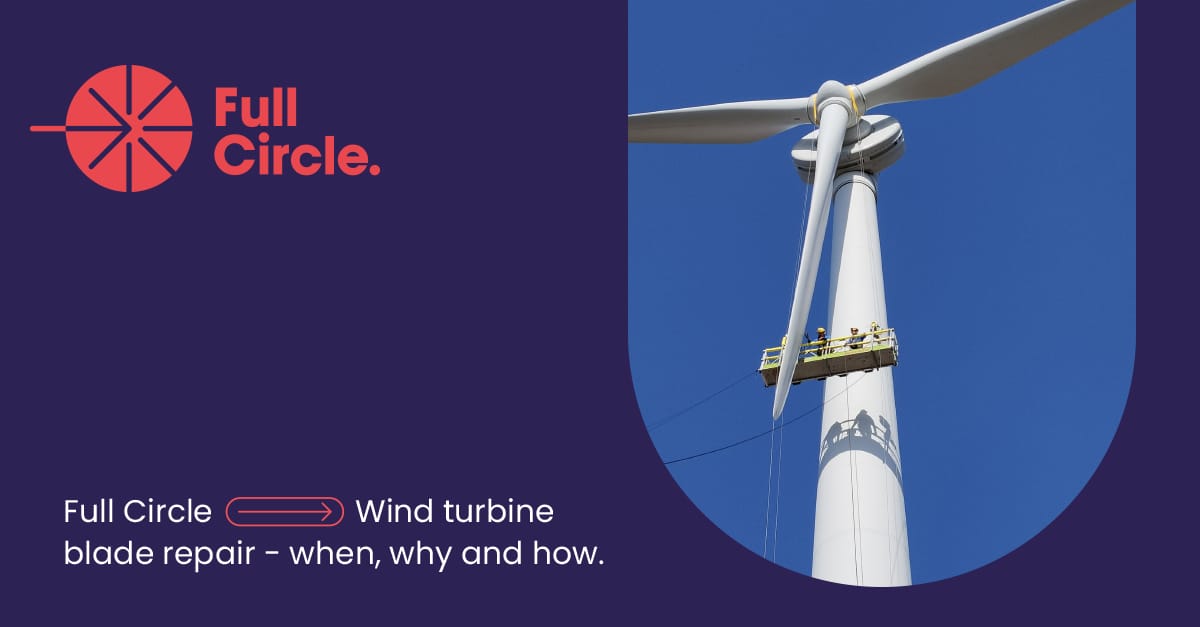- Older technology or historical factory defects
- Wear and tear
- Impact from external forces or objects
Wind turbines are a champion for our greener future, and we need to take care of these hard-working giants whilst they play their part in protecting our planet. So let’s take a quick look into the when, why and how of repairing the blades.
When do wind turbine blades need to be repaired?
Leading-Edge Erosion
The most common form of turbine blade wear and tear is leading-edge erosion. A factory-fresh modern blade should come with at least four years’ leading-edge protection, depending on the brand and the conditions where it’s located.
Turbine blades are the ultimate hard workers, turning at 100mph for years, in all weathers. The constant exposure to rain, wind, sun, sand, salt and ice wears down the coating on the leading edge of the blade.
Once it sets in, leading-edge erosion can disrupt the smooth surface of the blade, creating wind resistance, which affects optimal output. Left alone, erosion can turn into a bigger problem down the line, as the damage can penetrate the structure of the fibreglass.
Cracks and Delamination
Sometimes a turbine blade can develop cracks, or begin to delaminate. This could be due to erosion that’s been left for too long, allowing moisture to get into the body of the fibreglass and break down the structure.
Sometimes we find faults or weaknesses within the blades from when they were produced in the factory, but only come to light further down the line. The blades’ constant motion through the air can quickly exacerbate problems, which is why it’s so important to get them repaired as soon as possible.
Direct hits and strikes
Depending on location, some turbines are more prone than others to impact from foreign objects. Golf balls are a surprisingly common culprit of ‘pockmarking’, as are a wide variety of falling or windblown objects, while a bird strike can put a serious dent in proceedings. There are also ‘acts of God’ to contend with, such as lightning strikes.
Whether it’s just a minor dent or something more significant, most damage or wear and tear can be repaired in situ and at speed, minimising expensive downtime for the operator.

Photo credit, Cassie Boca, Unsplash.
Why is regular wind turbine maintenance a good idea?
Minimising wind turbine downtime
The pressure to keep wind turbines turning is three-fold: for the reliable provision of energy, healthy return on investment and consistent revenue streams.
Every turn of a turbine blade represents not only a vital revenue stream for its owner or investor, but also much-needed green energy for the grid. Even the slightest loss of efficiency from overdue maintenance, minor damage, or wear and tear, can have a big impact on output, and the bottom line.
Whilst it remains the cheapest of the renewables, an onshore turbine is still a significant investment, and a drop of just 1% in output can hit an operator or investor right where it hurts, especially a small-scale or heavily dependent single-turbine operation, such as a farm.
Increasing the lifespan of the blades
Many of the wind turbines in operation in the UK can be up to 20 years old, so it’s no surprise that some of them are starting to feel their age.
The last decade has seen major advances in technology and manufacturing techniques, not least due to digitalisation. Some older blades from the pre-2010 era are now prone to stress cracks and factory defects. However, with regular repair and maintenance there’s no reason older turbines shouldn’t keep turning for many more years to come.

Photo credit, Karsten Wurth, Unsplash.
How our technicians repair wind turbine blades.
Eyes in the sky
As most of us go about our daily routines at home or at work, the Full Circle Blades & Repair team are busy at ‘the office’, dangling from a rope 50 metres up, carrying a full kit of tools and materials, making sure the lights stay on for us on the ground.
Whether it’s re-coating a leading edge, or repairing major blade damage, every job starts with photographing the damage, conducting a toolbox talk and preparing the kits for rope access. Skilled technicians are then craned to the top of the turbine so that they can abseil down to the specific problem area on the blade and assess and repair it in situ.

Photo credit, EWT.
Repairing the fibreglass
Damaged material on the blade surface is removed, and the material beneath it is checked. Once the subsurface is repaired, the necessary replacement layers of fibreglass are cut to size, making sure the staggers and overlaps are all correct. The fibreglass is then laminated onto the blade surface with a resin mix, and is cured using a heated blanket. Finally, it’s inspected for voids and prepared for coating, any filler is sanded down and paint is applied.
Good day at the office
Each and every damaged blade presents a unique challenge, but the expert Full Circle team aim to complete an effective repair within a day, minimising downtime and helping to keep wind turbines turning. How many of us can say we have a rewarding job that benefits the planet, and with an office view that’s second to none?

Photo credit, Victor Stafancu, Unsplash.
To find out more about the Full Circle Blades & Repair service, get in contact with Craig Jones on +44 (0)7713 327378 or c.jones@fullcirclewindservices.com. We’d be delighted to help.
